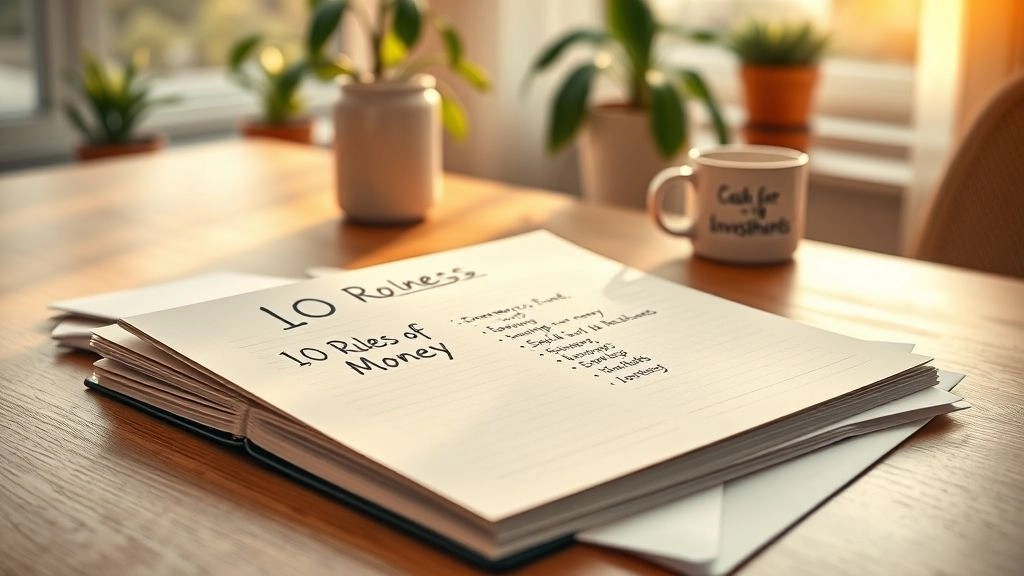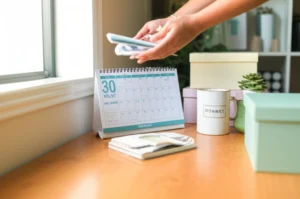Ever Wonder “Where Did My Money Go?”
Let’s just start here: Have you ever pulled up your online banking and thought, Wait—how am I already out of cash? (I’ll admit it, I’ve whispered a panicky “uh-oh” at the ATM more than once.) You’re not alone. I used to think saving money was just about sacrificing all the fun stuff—but honestly, it’s about small moves, not misery. The secret? There are maybe 10 rules of money that’ve kept me sane, debt-free, and—okay—I’ll say it… even kind of smug when things go sideways at the end of the month.
This isn’t going to be some stiff “here’s what you must do” finance lesson. I’m writing this like I would text a friend who just confessed their coffee habit was costing them more than their weekly groceries. (Because, yeah, I was that person once, too.) All the stuff here comes from a mix of books, podcasts, financial pros—plus about five years of trying/failing/retrying money strategies. These 10 rules aren’t magic, but they can honestly change the game—especially if you’re going for a frugal life that doesn’t suck all the joy out of living.
Why Do These Rules Work?
Here’s the thing—most money rules are just guardrails. Not handcuffs. The best ones let you tweak, adjust, and yep, break ’em when it makes sense. My version? They’re easy enough to scribble on a sticky note…but tough enough to actually make a difference. I took pages from Ramit Sethi, The Rules of money, and some good old trial and error.
What Makes a Rule Worth Following?
A real frugal money rule should make your life simpler, let you sleep at night, and—most importantly—set you up for those fun “heck yes!” moments later. Like last year, when my family did a surprise weekend getaway, all paid for in cash from savings. (True story. It was small but mighty. No guilt, no panic.)
Rule #1: Build Your Emergency Fund—First, Always
Let’s talk disaster prep. Not the “stockpile bottled water in your basement” kind, but the “oh crap, my car died and rent’s due Thursday” kind. That’s where the emergency fund comes in—it’s hands-down the best armor for a frugal life.
How Much Makes You Feel Safe?
You’ll get every answer from “just $1,000” to “stash a year’s salary!” Start where you are. I built mine up over months—when I hit $1,000 in a rainy day fund, I felt… relief. But I pushed for 3 months of bare-it-without-stress expenses. The best advice? Just start, and make saving automatic. (I used a free checking account that wasn’t connected to my debit card—so, less temptation to ‘borrow’ from myself.)
| Lifestyle | How Much? | Starter Goal |
|---|---|---|
| Solo, Simple Life | 3 months | $2,500—$4,000 |
| Family, Unpredictable | 6 months | $6,000—$12,000 |
| Ultra-Frugal Minimalist | 4 months | $3,000—$5,000 |
More importantly: Having even a small cushion makes you less likely to reach for the credit card when life goes sideways. (Ask me about the time my ancient Honda coughed up its transmission—$1,200 later, I was so grateful for my stashed “boring” fund.)
Pro tip: Some of the best personal finance books build off this. If you want a quick read, the 3 Rules of money book covers this, plus how to build habits so you keep the fund growing—without feeling deprived.
The First Dollars Out? To Yourself
This rule is everywhere, but barely anyone does it: Pay yourself first. The frugal way isn’t just “don’t spend”—it’s “save before you spend.” If you flip the script (send 15–20% to savings or investments immediately), there’s less left for mindless buys. Funny how what you don’t see, you don’t spend.
But How Much Is Enough?
Some folks swear by 10%. Others say shoot for 20%. I split the difference: I have 10% that goes into a “no touch” savings account, and another 10% that heads into investments automatically (like a retirement account or basic index fund—nothing wild). Even if you start at 3%, it adds up faster than you’d think. The real trick? Make it disappear before you feel it leave your checking account.
I got this one from my dad, by the way. Growing up, I’d watch him slide an envelope of cash into our kitchen junk drawer every payday. Emergency, Christmas, car repairs…it all “magically” came from that envelope. Turns out, magic was just him paying himself first—no apps, just envelopes.
Cash Beats Plastic for Big Purchases
One of the most powerful 10 rules of money? Pay cash (or at least, don’t go into debt) for life’s big moments. Weddings, dream trips, a used car—if you can’t cover most of it outright, pause. Do you really need it right now?
Wait, What About Credit Card Points?
I get it—everyone’s after points and rewards lately. Here’s my take: It only works if you always pay the card in full each month. Overspend? You’ll erase every “reward” (and then some) in interest fees. My “aha” moment happened when I’d racked up $700 in points… but $1,200 in debt. Brilliant, right? Not so much.
Sometimes paying cash hurts (watching money leave your hand is way more real than swiping plastic). But that pain? It keeps you frugal. And honestly, it makes the win so much sweeter. (Example: We paid for our tiny wedding with cash—we could’ve gone lavish, but choosing smaller kept us out of debt. The memories are worth more than any Pinterest-worthy cake.)
Avoid Lifestyle Creep (a Sneaky Budget Killer)
Have you noticed? Every time you get a raise or side hustle payout, the world (and your social media feed) tells you to “treat yourself.” But if you let each $100 extra become just “nicer” stuff, you’ll never really feel ahead.
How to Spot It?
Does your grocery bill double—even though your family size hasn’t? Swapping out a perfectly good phone for a slightly newer one? That’s lifestyle creep, and it’s the enemy of a frugal life. Instead, bank your pay raise. If you get a $2,000 bump this year, redirect half to savings immediately (and live on the same old budget).
Here’s my confession: I once let my “treat yourself” budget go wild after a promotion, and hit the end of the year wondering where my extra thousands went. I now “raise lock” my expenses—every extra dollar funds a future vacation or bumps up my investing. That’s literally rules of money management 101. Feels way better than an overpriced streaming service I never watch.
Budgeting Doesn’t Have to Be Torture
This one gets a groan—but budgeting doesn’t mean Excel nightmares. I like the zero-based method: give every dollar a job (whether it’s food, utility bills, or a pizza night). If you prefer buckets, try the 50/30/20 rule—just shift more to savings and less to “fun” if you want to put your money to work faster.
| Method | Best For… | Frugal Twist |
|---|---|---|
| 50/30/20 | Easy Math | Shrink “wants” to 10-15% |
| Zero-Based | Budget Skeptics | Save first; automate remainder |
Millionaires, by the way, are more likely to set up automated transfers or “artificial scarcity” than micromanage every penny, according to recent research on spending habits (check their findings here). Automation turns out to be friendlier than strict spreadsheets, honestly.
Invest Early, Invest Steady
Time in the market beats timing the market. That’s the old investing cliché, but it’s true. You don’t have to be Wall Street savvy either—just pick low-fee index funds and let them do their thing. (Fees matter, by the way. Even a 1% fee can eat away thousands over your lifetime. No, really… thousands!)
What’s the 120-minus-Age Rule?
Quick math for asset allocation: 120 minus your age = % to put in stocks; the rest into bonds or safer options. At 30, you’d put 90% in stocks; at 60, maybe just 60%. It’s a rule of thumb, not a commandment, but a helpful shortcut. (And yes, this idea’s made the rounds in popular guides, like 9 money rules, which is great to skim for more bite-size tips.)
Credit: Use, Don’t Abuse
Credit can be a frugal person’s friend… or the reason you can’t sleep at night. I use cards for rewards now—but only what I’d buy anyway. One late payment wipes out years of “cents back”. Basically, treat your cards like cash, and don’t buy anything you couldn’t instantly pay off with real money in your account.
Emergency-Only Exceptions
Though I swore off using cards for “emergencies,” I’d be lying if I didn’t once have to put a vet bill on the credit card. But here’s the catch: I had an emergency fund, so I used it to pay off the balance—immediately. No debt spiral, no interest trap. That’s the difference between wise and wild credit.
Plan Your Year, Not Just Your Month
Ever noticed how those “surprise” annual expenses—like car tags, birthdays, or holiday travel—always creep up? If you only budget month-to-month, those are budget bombs. So, once a year, I sit down, pour myself the fanciest coffee I allow, and list every big expense for the year. Then I break it down by month—and voila, fewer nasty surprises.
Let the Whole Family In
This one’s honestly priceless: share your money goals with your partner, roommates, or whoever’s in your financial world. Kids learn by watching—if you do monthly check-ins or “spending freeze” challenges together, it takes the shame out of money talk. (Inspired by those super practical tips in family-oriented guides like The Rules of money.)
Check Yourself Monthly (No Judgment, Just Curiosity)
You know how you can set up a recurring calendar reminder to water your plants? I have one for my budget review. End of every month, I glance at my account statements, find mystery charges (“how many streaming services did I subscribe to?!”), and reset any goals that went sideways. It’s not about perfection. It’s about not repeating the same “oops” two months in a row.
Catch a Leak Early
This habit once caught a gym membership I thought I’d canceled—turns out, I hadn’t. $35/month for nothing. Fixed it, and now I make sure there’s nothing zombie-like in my monthly expenses. If you screw up, no shame—just reset. That’s how you build real, sticky progress.
Real Wealth Stays (Mostly) Unseen
Here’s a plot twist: You might not see me in fancy shoes or with the latest watch. My “rich life” is… invisible. The best part of the 10 rules of money? Compounded wins. It’s not that I never spend, it’s that I keep the big picture in focus (like the Rule of 72—how compounding doubles your stash quietly, over time). Living frugally lets me say yes when it matters—and a gentle no to all the stuff that fades fast anyway.
| Frugal Move | 10-Year Savings |
|---|---|
| No new car (drive used) | $30,000+ |
| Home-cooked dinner | $10,000+ |
Most of your wins won’t make for a flashy Instagram post, but trust me: quiet net worth feels way better than viral likes. If you want to geek out more, browse the 3 Rules of money book or the 9 money rules guides. Lots of actionable nuggets there.
Wrapping Up—Your Next Step (Promise, No Judging)
Here we are. These 10 rules of money aren’t commandments… but they are the secret sauce to ditching “where did it all go?” panic and building something real. Maybe you’ve got an emergency fund started. Maybe you’re still circling the idea. Doesn’t matter. Just pick one rule today—automate a tiny amount to savings, say. Or spend 10 minutes tracking last month’s expenses (wine/mood lighting: optional, but recommended).
Steady progress beats perfect plans. And believe me, knowing you’re setting up safety nets, planning ahead, and outsmarting lifestyle creep will give you a quiet kind of confidence money can’t buy. Let’s share wins, vent about slip-ups, and swap frugal tricks along the way. I’d love to hear: What’s the rule you’re going to start with next? Fine by me if it’s the smallest step in the world—it all adds up. Let’s do this—for your wallet, your future self, and heck, for that next guilt-free pizza night.













